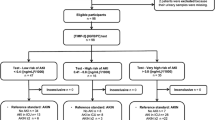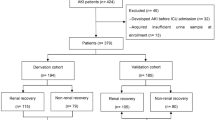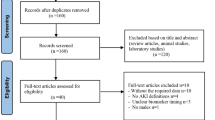Abstract
Background
Poor prognosis has been associated with the absence of renal recovery after acute kidney injury (AKI). This study aimed to investigate whether urinary biomarkers at 0 and 24 h could be used independently or in conjunction with a clinical model to predict renal non-recovery in septic AKI.
Methods
A prospective observational study was conducted to measure the urinary levels of insulin-like growth factor-binding protein 7 (IGFBP7) and tissue inhibitor of metalloproteinase-2 (TIMP-2) at the time of AKI diagnosis (0 h) and 24 h later. Renal non-recovery within 7 days was defined as the outcome. The predictive value of urinary biomarkers for renal non-recovery in septic AKI was assessed using the area under the curve (AUC).
Results
A total of 198 individuals with septic AKI were included in the final analysis. Among them, 38.9% (n = 77) did not experience renal recovery within 7 days. The combination of urinary IGFBP7 and TIMP-2 at the initial time point demonstrated prognostic value for non-recovery of renal function, with an AUC of 0.782. When [TIMP-2]*[IGFBP7] was measured at 0 h, the clinical prognostic model, incorporating AKI stage 2–3 and the non-renal sequential organ failure assessment score, showed an improved AUC of 0.822 (with a sensitivity of 88.3% and specificity of 59.5%).
Conclusions
The combination of urinary [TIMP-2]*[IGFBP7] at 0 h exhibited moderate predictive ability for renal non-recovery in cases of septic AKI. However, there is potential to enhance the prognostic capabilities of the [TIMP-2]*[IGFBP7]–clinical prediction model.


Similar content being viewed by others
Availability of data and materials
All data generated and/or analyzed during this study are included in this published article.
Abbreviations
- AKI:
-
Acute kidney injury
- TIMP-2:
-
Tissue inhibitor of metalloproteinase-2
- IGFBP7:
-
Insulin-like growth factor-binding protein 7
- AUC:
-
The area under the curve
- SOFA:
-
Sequential organ failure assessment
- CKD:
-
Chronic kidney disease
- ICU:
-
Intensive Care Unit
- UO:
-
Urine output
- RRT:
-
Renal replacement therapy
- KDIGO:
-
Kidney Disease: Improving Global Outcomes
- SCr:
-
Serum creatinine
- GFR:
-
Glomerular filtration rate
- APACHE II:
-
Acute physiology and chronic health evaluation
- SD:
-
Standard deviation
- IQR:
-
Interquartile range
- ROC:
-
Receiver operating characteristic
- PPV:
-
Positive predictive value
- NPV:
-
Negative predictive value
- CI:
-
Confidence interval
References
Zhang Z. Biomarkers, diagnosis and management of sepsis-induced acute kidney injury: a narrative review. Heart Lung Vessel. 2015;7:64–73.
Pettilä V, Bellomo R. Understanding acute kidney injury in sepsis. Intensive Care Med. 2014;40:1018–20.
Franzin R, Stasi A, Fiorentino M, Simone S, Oberbauer R, Castellano G, et al. Renal delivery of pharmacologic agents during machine perfusion to prevent ischaemia-reperfusion injury: from murine model to clinical trials. Front Immunol. 2021;12:673562.
Schrier RW, Wang W. Acute renal failure and sepsis. N Engl J Med. 2004;351:159–69.
Swaminathan M, Hudson CC, Phillips-Bute BG, Patel UD, Mathew JP, Newman MF, et al. Impact of early renal recovery on survival after cardiac surgery-associated acute kidney injury. Ann Thorac Surg. 2010;89:1098–104.
Kellum JA, Sileanu FE, Bihorac A, Hoste EA, Chawla LS. Recovery after acute kidney injury. Am J Respir Crit Care Med. 2017;195:784–91.
Federspiel CK, Itenov TS, Mehta K, Hsu RK, Bestle MH, Liu KD. Duration of acute kidney injury in critically ill patients. Ann Intensive Care. 2018;8:30.
Stasi A, Franzin R, Caggiano G, Losapio R, Fiorentino M, Alfieri C, et al. New frontiers in sepsis-induced acute kidney injury and blood purification therapies: the role of polymethylmethacrylate membrane hemofilter. Blood Purif. 2023;52:1–14.
Stasi A, Franzin R, Fiorentino M, Squiccimarro E, Castellano G, Gesualdo L. Multifaced Roles of HDL in Sepsis and SARS-CoV-2 Infection: Renal Implications. Int J Mol Sci. 2021;22:5980.
Kashani K, Al-Khafaji A, Ardiles T, Artigas A, Bagshaw SM, Bell M, et al. Discovery and validation of cell cycle arrest biomarkers in human acute kidney injury. Crit Care. 2013;17:R25.
Forni LG, Darmon M, Ostermann M, Oudemans-van Straaten HM, Pettilä V, Prowle JR, et al. Renal recovery after acute kidney injury. Intensive Care Med. 2017;43:855–66.
Pickkers P, Ostermann M, Joannidis M, Zarbock A, Hoste E, Bellomo R, et al. The intensive care medicine agenda on acute kidney injury. Intensive Care Med. 2017;43:1198–209.
Ostermann M, Joannidis M. Acute kidney injury 2016: diagnosis and diagnostic workup. Crit Care. 2016;20:299.
Chawla LS, Bellomo R, Bihorac A, Goldstein SL, Siew ED, Bagshaw SM, et al. Acute kidney disease and renal recovery: consensus report of the Acute Disease Quality Initiative (ADQI) 16 Workgroup. Nat Rev Nephrol. 2017;13:241–57.
Helou R. Should we continue to use the Cockcroft-Gault formula. Nephron Clin Pract. 2010;116:172–85 (discussion c86).
Pilarczyk K, Edayadiyil-Dudasova M, Wendt D, Demircioglu E, Benedik J, Dohle DS, et al. Urinary [TIMP-2]*[IGFBP7] for early prediction of acute kidney injury after coronary artery bypass surgery. Ann Intensive Care. 2015;5:50.
Singer M, Deutschman CS, Seymour CW, Shankar-Hari M, Annane D, Bauer M, et al. The third international consensus definitions for sepsis and septic shock (Sepsis-3). JAMA. 2016;315:801–10.
Bellomo R, Kellum JA, Ronco C, Wald R, Martensson J, Maiden M, et al. Acute kidney injury in sepsis. Intensive Care Med. 2017;43:816–28.
Tandukar S, Palevsky PM. Continuous renal replacement therapy: Who, When, Why, and How. Chest. 2019;155:626–38.
Rachoin JS, Weisberg LS. Renal Replacement Therapy in the ICU. Crit Care Med. 2019;47:715–21.
Dewitte A, Joannès-Boyau O, Sidobre C, Fleureau C, Bats ML, Derache P, et al. Kinetic eGFR and Novel AKI biomarkers to predict renal recovery. Clin J Am Soc Nephrol. 2015;10:1900–10.
Titeca-Beauport D, Daubin D, Van Vong L, Belliard G, Bruel C, Alaya S, et al. Urine cell cycle arrest biomarkers distinguish poorly between transient and persistent AKI in early septic shock: a prospective, multicenter study. Crit Care. 2020;24:280.
Jia HM, Cheng L, Weng YB, Wang JY, Zheng X, Jiang YY, et al. Cell cycle arrest biomarkers for predicting renal recovery from acute kidney injury: a prospective validation study. Ann Intensive Care. 2022;12:14.
Gombert A, Kotelis D, Rückbeil MV, Barbati M, Martin L, Marx G, et al. Increase of urinary TIMP-2 and IGFBP7 as potential predictor of acute kidney injury requiring renal replacement therapy and patients’ outcome following complex endovascular and open thoracic abdominal aortic aneurysm surgery - a prospective observational study. Vasa. 2021;50:101–9.
Palevsky PM, Zhang JH, O’Connor TZ, Chertow GM, Crowley ST, Choudhury D, et al. Intensity of renal support in critically ill patients with acute kidney injury. N Engl J Med. 2008;359:7–20.
Aregger F, Uehlinger DE, Fusch G, Bahonjic A, Pschowski R, Walter M, et al. Increased urinary excretion of kynurenic acid is associated with non-recovery from acute kidney injury in critically ill patients. BMC Nephrol. 2018;19:44.
Acknowledgements
We thank Professor Li-Rong Liang from Beijing Chao-Yang Hospital for the statistical analysis and Medjaden Inc. for the scientific editing of this manuscript.
Funding
This study is supported by Beijing Municipal Science & Technology Commission (No. Z181100001718204; No. Z191100006619032).
Author information
Authors and Affiliations
Contributions
LC contributed to urine collection, data interpretation, manuscript drafting, and critical revision. H-M J, XZ, and Y-J J contributed to urine collection and data interpretation and performed statistical analysis. H-M J, XZ, Y-J J, and T-E Z contributed to data collection and interpretation. W-X L chaired the group, conceived and designed the study, performed statistical analysis and contributed to data collection, interpretation, and critical manuscript revision. All the authors reviewed the manuscript. All the authors read and approved the final manuscript.
Corresponding author
Ethics declarations
Conflict of interest
The authors have declared that no conflict of interest exists.
Ethical approval
This study was approved by the Human Ethics Committee of Beijing Chao-Yang Hospital, Capital Medical University (Beijing, China). All procedures performed in studies involving human participants were per the ethical standards of the institutional and/or national research committee at which the studies were conducted (IRB approval number 2018-117) and with the 1964 Helsinki Declaration and its later amendments or comparable ethical standards.
Informed consent
Written informed consent was obtained from all individual participants included in the study.
Additional information
Publisher's Note
Springer Nature remains neutral with regard to jurisdictional claims in published maps and institutional affiliations.
Supplementary Information
Below is the link to the electronic supplementary material.
Supplementary file 1—Figure S1.
The comparisons of urinary [TIMP-2]*[IGFBP7] levels of AKI stage 1 and stage 2–3 at 0 and 24 h. a: The comparison of urinary [TIMP-2]*[IGFBP7] levels of AKI stage 1 and stage 2–3 at 0 h. b: The comparison of urinary [TIMP-2]*[IGFBP7] levels of AKI stage 1 and stage 2–3 at 24 h. Abbreviations: AKI, acute kidney injury; TIMP-2, Tissue inhibitor of metalloproteinase-2; IGFBP7, Insulin-like growth factor-binding protein 7 (TIF 109 KB)
Supplementary file 2—Figure S2.
AUCs of [TIMP-2]*[IGFBP7] at AKI diagnosis (0 h) for RRT use, 30 day mortality. a: The AUC of [TIMP-2]*[IGFBP7] at AKI diagnosis (0 h) for RRT use. b: The AUC of [TIMP-2]*[IGFBP7] at AKI diagnosis (0 h) for 30 day mortality. Abbreviations: ROC, receiver operating characteristic; AUC, the area under the curve; TIMP-2, Tissue inhibitor of metalloproteinase-2; IGFBP7, Insulin-like growth factor-binding protein 7 (TIF 165 KB)
About this article
Cite this article
Cheng, L., Jia, HM., Zheng, X. et al. Urinary cell cycle biomarkers for the prediction of renal non-recovery in patients with septic acute kidney injury: a prospective study. Clin Exp Nephrol 27, 1051–1059 (2023). https://doi.org/10.1007/s10157-023-02397-z
Received:
Accepted:
Published:
Issue Date:
DOI: https://doi.org/10.1007/s10157-023-02397-z




